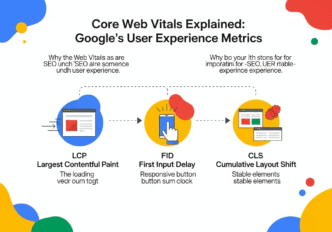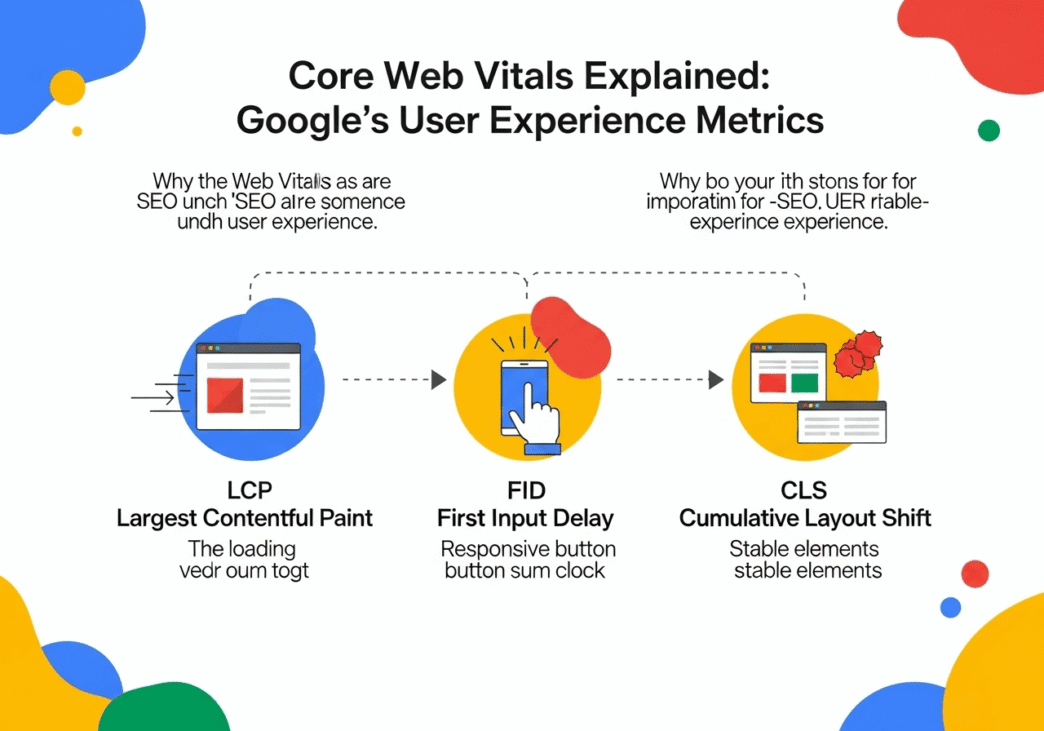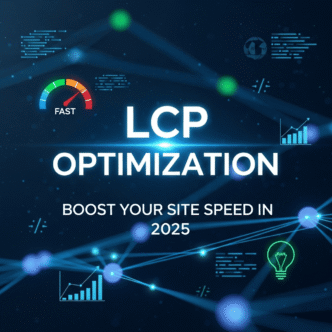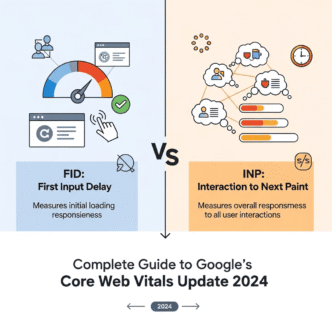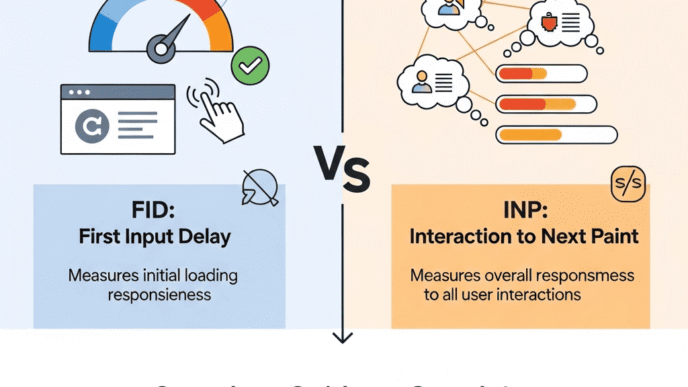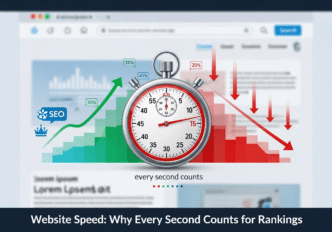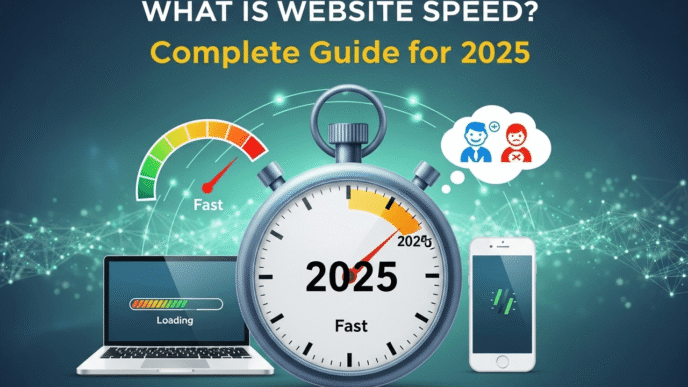Lorem ipsum dolor sit amet, consectetur adipiscing elit. Ut elit tellus, luctus nec ullamcorper mattis, pulvinar dapibus leo.
Table of Contents
Toggle
Introduction: The User Experience Revolution {#introduction}
Ever clicked on a website only to sit there tapping your fingers while it loads slower than molasses? Or maybe you’ve tried to click a button, but the page suddenly shifted and you ended up clicking an ad instead? We’ve all been there, and Google knows it too.
That’s exactly why Core Web Vitals exist – Google’s way of measuring whether your website delivers the smooth, frustration-free experience users actually want. Think of Core Web Vitals as your website’s report card for user experience, and trust me, you want good grades here because they directly impact your SEO rankings.
What Are Core Web Vitals and Why Do They Matter So Much? {#what-are-core-web-vitals}
Core Web Vitals are three specific user experience metrics that Google uses to evaluate how well your website performs from a real user’s perspective. These aren’t just technical numbers that make developers happy – they’re measurements of actual user frustration (or satisfaction).
Here’s the thing: Google cares about user experience because happy users mean better search results. And better search results mean people keep using Google. It’s a win-win situation, except when your website is the one making users unhappy.
The three core metrics focus on:
- Loading performance (how fast your content appears)
- Interactivity (how quickly users can actually use your page)
- Visual stability (whether elements jump around like caffeinated squirrels)
The Big Three: Understanding LCP, FID, and CLS {#the-big-three}
Let’s break down each of these website performance metrics without getting too technical. Think of them as the holy trinity of page experience.
LCP (Largest Contentful Paint): The Speed Demon
LCP measures how long it takes for the largest visible element on your page to load. This could be a hero image, a video, or a big block of text – basically, the main thing users came to see.
Good LCP Score: 2.5 seconds or less Needs Improvement: 2.5-4 seconds
Poor: Over 4 seconds
Real-world example: Imagine visiting an online store. The product image is usually the largest element. If it takes 5 seconds to appear, you’ve probably already hit the back button and gone to Amazon instead.
Pro Tip: “Most users will abandon a page if the main content takes longer than 3 seconds to load. Optimize your images and consider lazy loading for elements below the fold.” – Web Performance Expert
FID (First Input Delay): The Responsiveness Champion
FID measures the delay between when a user first interacts with your page (clicks a button, taps a link) and when the browser actually responds to that interaction.
Good FID Score: 100 milliseconds or less Needs Improvement: 100-300 milliseconds Poor: Over 300 milliseconds
Think about it like this: You knock on someone’s door, but they don’t answer for 30 seconds. Frustrating, right? That’s what high FID feels like to your users.
CLS (Cumulative Layout Shift): The Stability Keeper
CLS measures how much visible elements move around during loading. You know that annoying moment when you’re about to click something and the page shifts, making you click the wrong thing? That’s layout shift.
Good CLS Score: 0.1 or less Needs Improvement: 0.1-0.25 Poor: Over 0.25
Core Web Vitals Comparison Table
| Metric | What It Measures | Good Score | Impact on User |
|---|---|---|---|
| LCP | Loading Performance | ≤ 2.5s | How fast main content appears |
| FID | Interactivity | ≤ 100ms | How quickly page responds to clicks |
| CLS | Visual Stability | ≤ 0.1 | How much content jumps around |
How Do Core Web Vitals Impact Your SEO Rankings? {#seo-impact}
Here’s where things get interesting for SEO folks. Google officially made Core Web Vitals a ranking factor in 2021 as part of their page experience update. But don’t panic – they’re not the be-all-end-all of rankings.
Google uses these metrics as a tie-breaker. If two pages have similar content quality and relevance, the one with better Core Web Vitals will likely rank higher.
Real Case Study: A major e-commerce site improved their LCP from 4.2 seconds to 1.8 seconds and saw a 15% increase in organic traffic within three months. Their bounce rate also dropped by 20%.
Key Statistics: The Numbers That Matter
The data tells a compelling story about Core Web Vitals impact on business success:
Performance Impact Statistics:
- 53% of users will abandon a site if it takes more than three seconds to load
- Vodafone: 31% improvement in LCP led to 8% more sales
- Swappie: Achieved 42% higher mobile revenue after optimization
- eBay: Just 100ms faster load times resulted in 0.5% more “Add to Cart” actions
- Renault: Every 1-second LCP improvement reduced bounce rates by 14% and increased conversions by 13%
SEO and Ranking Statistics:
- Core Web Vitals improvements can increase impressions by up to 20%
- Websites with optimized CWV scores generate 22% more backlinks
- Sites with poor INP scores see a 15% drop in engagement metrics
- Websites with a CWV score above 90 have a 50% higher chance of ranking in the top 3 results
- CoinStats increased the number of URLs with ‘Good’ Core Web Vitals scores by 300% – and search impressions by the same amount
How to Measure Core Web Vitals Performance
You can’t improve what you don’t measure. Here are the best tools to check your Core Web Vitals scores:
Free Tools:
- Google PageSpeed Insights – The gold standard
- Google Search Console – Shows real user data
- Chrome DevTools – For detailed debugging
- Web.dev Measure – Quick and simple testing
What Each Tool Shows:
- Lab Data: Controlled environment testing
- Field Data: Real user experiences from actual visitors
Pro Tip: “Always prioritize field data over lab data when making optimization decisions. Real user experiences matter more than perfect testing conditions.”
Core Web Vitals Optimization Guide: Practical Solutions {#optimization-guide}
Improving LCP (Loading Performance)
Common culprits and fixes:
Optimize Images
- Use modern formats (WebP, AVIF)
- Implement proper sizing and compression
- Add lazy loading for below-the-fold images
Reduce Server Response Time
- Choose faster hosting
- Use a Content Delivery Network (CDN)
- Enable browser caching
Eliminate Render-Blocking Resources
- Minify CSS and JavaScript
- Remove unused code
- Load critical CSS inline
Fixing FID (Interactivity Issues)
Key strategies:
Reduce JavaScript Execution Time
- Break up long-running tasks
- Use web workers for heavy computations
- Defer non-critical JavaScript
Optimize Third-Party Scripts
- Audit unnecessary plugins
- Load scripts asynchronously
- Use resource hints (preload, prefetch)
Solving CLS (Visual Stability Problems)
Prevention techniques:
Set Size Attributes
- Define dimensions for images and videos
- Reserve space for dynamic content
- Use CSS aspect-ratio property
Avoid Dynamic Content Insertion
- Don’t inject content above existing elements
- Use placeholders for loading content
- Test with slow network connections
What Are Core Web Vitals Thresholds for Success?
Google evaluates Core Web Vitals based on the 75th percentile of real user experiences. This means 75% of your users should have scores in the “Good” range.
Success Benchmarks:
- LCP: 75% of page loads under 2.5 seconds
- FID: 75% of interactions under 100 milliseconds
- CLS: 75% of page loads with CLS under 0.1
Core Web Vitals Tools Comparison
| Tool | Data Type | Best For | Cost |
|---|---|---|---|
| PageSpeed Insights | Lab + Field | Quick overview | Free |
| Search Console | Field only | Historical trends | Free |
| Chrome DevTools | Lab only | Detailed debugging | Free |
| GTmetrix | Lab + Field | Comprehensive analysis | Free/Paid |
| WebPageTest | Lab only | Advanced testing | Free |
Common Core Web Vitals Mistakes to Avoid {#common-mistakes}
Even experienced developers and SEO professionals can fall into these Core Web Vitals traps. Here are the most critical mistakes that can sabotage your optimization efforts:
1. Focusing Only on Desktop Performance
Many teams optimize for desktop first, then discover their mobile scores are dramatically different. According to research, 53% of users will abandon a site if it takes more than three seconds to load, and this impatience is even more pronounced on mobile devices.
Why this happens: Desktop testing environments often have faster processors and better network connections than real mobile devices.
2. Relying Exclusively on Lab Data
Lab scores look pretty, but field data shows what actual users experience. Google uses real user data (field data) for rankings, not simulated lab tests.
The reality: Lab data is often collected on a slower network connection than is typical for real users, and Google looks at the slowest 25% of experience, while a lab test result may be closer to the slowest 5-10% of experiences.
3. Over-Optimizing for One Metric
Don’t sacrifice FID (or INP) to improve LCP. The approach shifted from penalizing slow pages to rewarding fast ones, but Google evaluates all three metrics together.
4. Ignoring the 28-Day Rule
Google collects Core Web Vitals data on a 28-day sliding window. Your score is essentially the average score of the last 28 days. Many teams panic when they don’t see immediate improvements.
5. Forgetting About Content Above the Fold
Your hero section usually contains the LCP element – optimize it first. Yet many teams focus on below-the-fold optimizations that won’t impact the largest contentful paint.
6. Treating Core Web Vitals as Just an SEO Issue
This is business-critical beyond rankings. Vodafone saw a 31% improvement in LCP that led to 8% more sales, while Swappie achieved 42% higher mobile revenue after optimization.
7. Not Testing with Real Devices
Simulated mobile testing misses device-specific performance issues. Real devices have memory constraints, thermal throttling, and varying processor speeds that simulators can’t replicate.
AI and Core Web Vitals: The Future of SEO in 2025 {#ai-trends}
The intersection of AI and Core Web Vitals is reshaping how we approach website performance optimization. Here’s what’s changing:
AI-Powered Optimization Tools
Machine learning/AI, Core Web Vitals, and E-E-A-T (Expertise, Experience, Authoritativeness, and Trustworthiness) now influence global search rankings. Modern AI tools can:
- Predictive Analysis: AI systems analyze vast datasets to predict which Core Web Vitals issues will impact your rankings most
- Real-time Monitoring: 47% of marketers are already implementing AI SEO tools to improve search efficiency
- Automated Optimization: AI can automatically compress images, optimize code, and implement performance improvements
The Great Decoupling Effect
AI Overviews are reducing website clicks by over 30%, even as visibility increases. This means Core Web Vitals optimization is more crucial than ever – you need to convert the traffic you do get.
Search Everywhere Optimization
With the rise of AI search engines like ChatGPT and Perplexity, Core Web Vitals optimization now serves multiple platforms. AI search was driving less than 1% of traffic to most websites as of June 2025, but this is rapidly growing.
Voice Search and Core Web Vitals
Around 50% of U.S. consumers use voice search every day. Fast-loading, responsive sites perform better in voice search results, making INP optimization particularly crucial.
Future-Focused Tip: “AI doesn’t just power search engines – it’s changing marketers’ tools too. About 51% of marketers use AI tools to optimize their content for search engines. The key is using AI to enhance, not replace, human expertise in Core Web Vitals optimization.”
Your Core Web Vitals Action Plan
Ready to improve your Core Web Vitals scores? Here’s your step-by-step roadmap:
Audit Current Performance
- Run PageSpeed Insights on key pages
- Check Search Console for field data
- Identify your worst-performing pages
Prioritize Quick Wins
- Optimize images (often the biggest impact)
- Enable compression and caching
- Remove unused plugins and scripts
Address Technical Issues
- Fix render-blocking resources
- Set proper image dimensions
- Optimize server response times
Monitor and Iterate
- Set up regular monitoring
- Track improvements over time
- Test changes with real users
Helpful Resources and External Tools {#resources}
To dive deeper into Core Web Vitals optimization, these authoritative resources provide comprehensive guidance:
- Google’s Core Web Vitals Documentation – Official Google guidance on Core Web Vitals metrics and optimization strategies
- Web.dev Core Web Vitals – Google’s comprehensive learning resource with practical optimization techniques
- Chrome UX Report – Access real user experience data that Google uses for rankings
These resources offer detailed technical implementation guides and the latest updates directly from Google’s development teams.
Final Verdict: Your Core Web Vitals Success Strategy {#final-verdict}
After analyzing the data, trends, and real-world case studies, here’s the bottom line: Core Web Vitals aren’t just another SEO checkbox – they’re fundamental business metrics that directly impact your revenue.
The Evidence is Clear:
The statistics don’t lie. Companies like Vodafone, Swappie, and eBay have seen measurable business impact from Core Web Vitals improvements. When 53% of users abandon slow sites and Core Web Vitals improvements can increase impressions by up to 20%, optimization becomes a business imperative.
The AI Revolution Changes Everything:
With AI Overviews appearing in 13.14% of search queries and AI search engines gaining traction, Core Web Vitals optimization now serves multiple platforms. The future isn’t just about ranking on Google – it’s about performing well across the entire search ecosystem.
Your Action Plan Moving Forward:
- Start with measurement using Google’s official tools
- Focus on mobile-first optimization since that’s where most traffic originates
- Implement AI-powered monitoring tools to stay ahead of issues
- Remember the 28-day rule and be patient with results
- Track business metrics, not just technical scores
Frequently Asked Questions About Core Web Vitals {#faq}
What exactly are Core Web Vitals and why should I care?
Core Web Vitals are three specific metrics that Google uses to measure real user experience on your website: LCP (loading speed), INP (responsiveness), and CLS (visual stability). You should care because 53% of users abandon sites that take over 3 seconds to load, and Google uses these metrics as ranking factors.
How long does it take to see Core Web Vitals improvements in search rankings?
Google collects Core Web Vitals data on a 28-day sliding window, so expect up to one month to see the full impact of your optimizations. This is why consistent monitoring and patience are crucial for successful optimization.
Are Core Web Vitals more important for mobile or desktop?
Google evaluates Core Web Vitals separately for mobile and desktop searches, meaning your site can rank differently on each platform. However, with mobile-first indexing and the fact that most traffic comes from mobile devices, mobile optimization should be your priority.
Can AI tools really help improve Core Web Vitals scores?
Yes, 47% of marketers are already using AI SEO tools to improve search efficiency. AI can automate image compression, predict performance issues, and provide real-time monitoring. However, human expertise is still needed for strategic decisions and implementation.
What’s the difference between lab data and field data for Core Web Vitals?
Lab data comes from controlled testing environments (like Lighthouse), while field data reflects real user experiences. Google uses field data for rankings because it represents actual user experiences. Lab data is helpful for debugging, but field data is what matters for SEO.
Do Core Web Vitals affect conversions beyond just SEO rankings?
Absolutely. Vodafone saw 31% LCP improvement lead to 8% more sales, while eBay gained 0.5% more “Add to Cart” actions from just 100ms faster load times. Core Web Vitals optimization improves both search rankings and business metrics.
How do Core Web Vitals relate to AI search engines like ChatGPT?
As AI search engines gain popularity (ChatGPT is already the 5th most visited site globally), good Core Web Vitals help your content get referenced in AI responses. Fast, stable sites are more likely to be cited by AI systems pulling from the web.
This comprehensive guide serves as your definitive resource for understanding and optimizing Core Web Vitals. Bookmark this page and return to specific sections as you implement improvements to your website’s performance.
Last updated: August 2025 | This guide reflects the latest Google updates including INP replacing FID and current AI search trends.
Core Web Vitals Interactive Guide
Understanding Google's User Experience Metrics
Target: ≤ 2.5 seconds
Target: ≤ 200ms
Target: ≤ 0.1
Core Web Vitals Impact Statistics
Business Impact of Core Web Vitals Optimization
(Vodafone)
(Swappie)
(eBay)
(Average)
Explore Optimization Strategies
Click on a metric to see specific optimization techniques
• Implement lazy loading for below-the-fold content
• Use CDN for faster content delivery
• Minimize server response time
• Preload critical resources

